Comparative Analysis: Mood Stabilizers vs. Antidepressants Treatment
VerifiedAdded on 2022/09/15
|5
|1218
|12
Report
AI Summary
This report provides a comprehensive overview of mood stabilizers and antidepressants, detailing their benefits, risks, and research base. It explores the use of these medications in treating conditions like bipolar disorder and depression, examining the efficacy of each treatment and potential side effects such as weight gain, drowsiness, and withdrawal symptoms. The report also compares the research backing for each treatment modality, with a focus on the neuro-hormonal pathway of antidepressants and the anti-maniac properties of mood stabilizers. It concludes with a recommendation for treatment approaches for teenagers, highlighting the use of mood stabilizers coupled with cognitive behavior therapies, while cautioning against the use of certain psychoactive medications that may increase risks among adolescents. The report references several studies to support its findings.
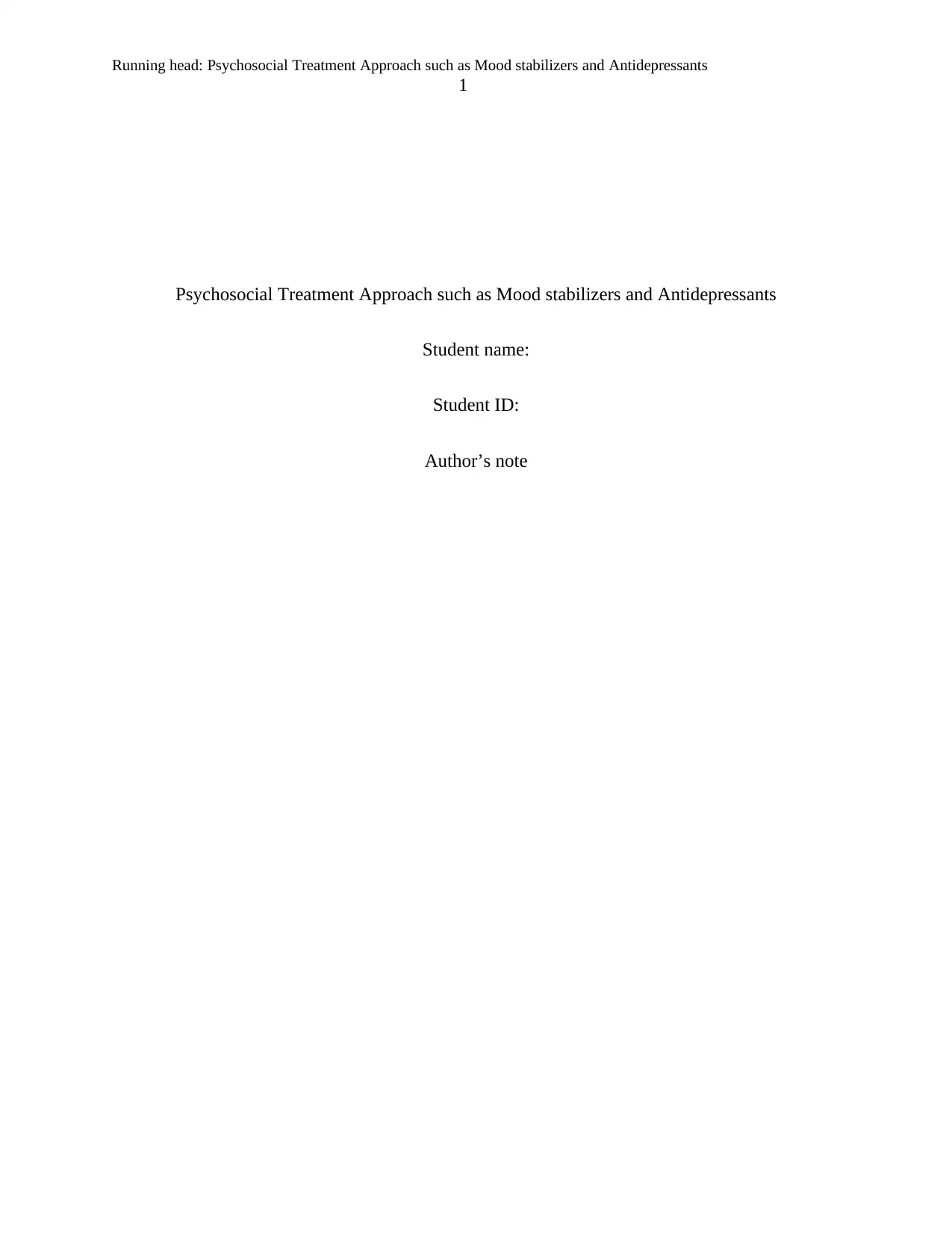
Running head: Psychosocial Treatment Approach such as Mood stabilizers and Antidepressants
1
Psychosocial Treatment Approach such as Mood stabilizers and Antidepressants
Student name:
Student ID:
Author’s note
1
Psychosocial Treatment Approach such as Mood stabilizers and Antidepressants
Student name:
Student ID:
Author’s note
Paraphrase This Document
Need a fresh take? Get an instant paraphrase of this document with our AI Paraphraser
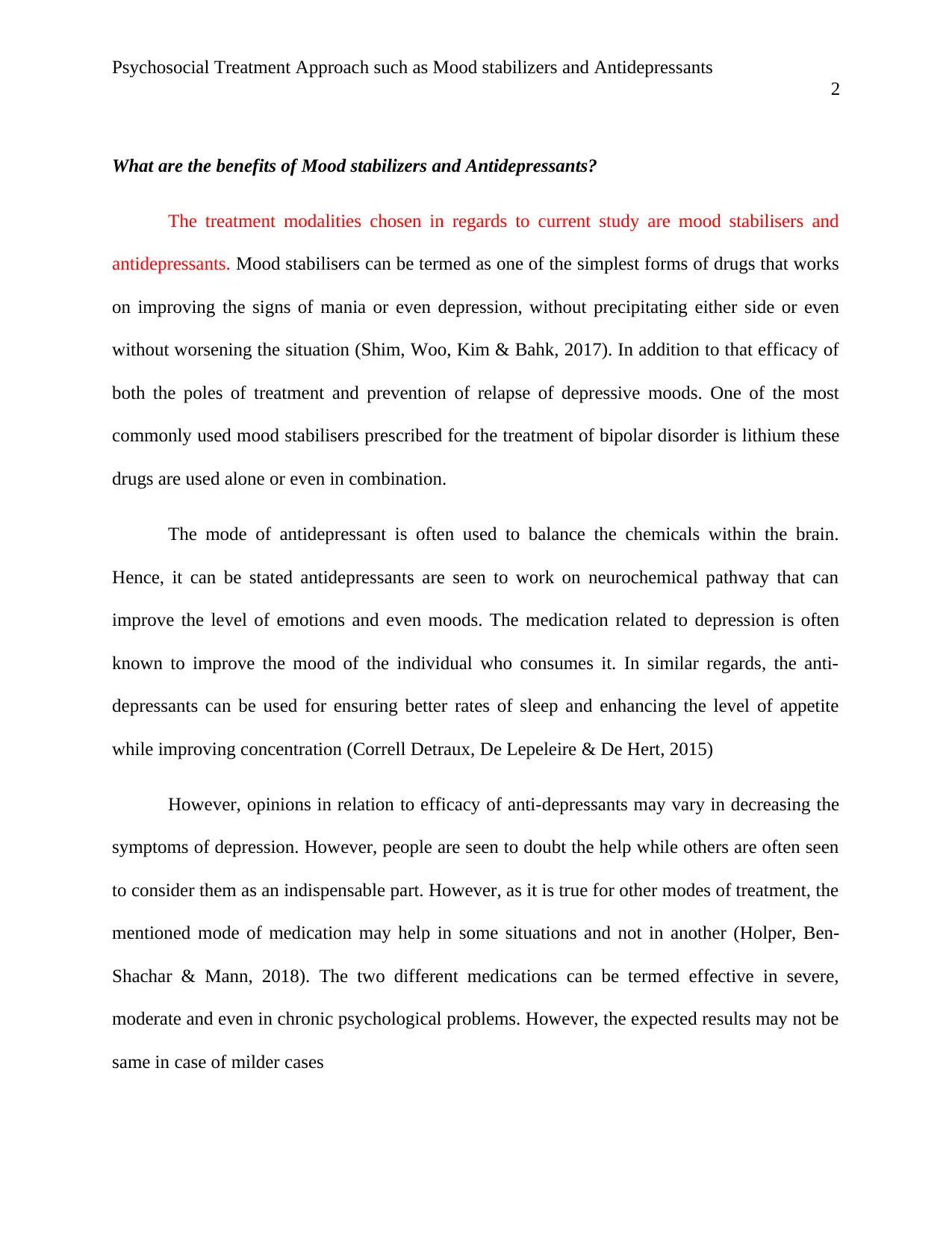
Psychosocial Treatment Approach such as Mood stabilizers and Antidepressants
2
What are the benefits of Mood stabilizers and Antidepressants?
The treatment modalities chosen in regards to current study are mood stabilisers and
antidepressants. Mood stabilisers can be termed as one of the simplest forms of drugs that works
on improving the signs of mania or even depression, without precipitating either side or even
without worsening the situation (Shim, Woo, Kim & Bahk, 2017). In addition to that efficacy of
both the poles of treatment and prevention of relapse of depressive moods. One of the most
commonly used mood stabilisers prescribed for the treatment of bipolar disorder is lithium these
drugs are used alone or even in combination.
The mode of antidepressant is often used to balance the chemicals within the brain.
Hence, it can be stated antidepressants are seen to work on neurochemical pathway that can
improve the level of emotions and even moods. The medication related to depression is often
known to improve the mood of the individual who consumes it. In similar regards, the anti-
depressants can be used for ensuring better rates of sleep and enhancing the level of appetite
while improving concentration (Correll Detraux, De Lepeleire & De Hert, 2015)
However, opinions in relation to efficacy of anti-depressants may vary in decreasing the
symptoms of depression. However, people are seen to doubt the help while others are often seen
to consider them as an indispensable part. However, as it is true for other modes of treatment, the
mentioned mode of medication may help in some situations and not in another (Holper, Ben-
Shachar & Mann, 2018). The two different medications can be termed effective in severe,
moderate and even in chronic psychological problems. However, the expected results may not be
same in case of milder cases
2
What are the benefits of Mood stabilizers and Antidepressants?
The treatment modalities chosen in regards to current study are mood stabilisers and
antidepressants. Mood stabilisers can be termed as one of the simplest forms of drugs that works
on improving the signs of mania or even depression, without precipitating either side or even
without worsening the situation (Shim, Woo, Kim & Bahk, 2017). In addition to that efficacy of
both the poles of treatment and prevention of relapse of depressive moods. One of the most
commonly used mood stabilisers prescribed for the treatment of bipolar disorder is lithium these
drugs are used alone or even in combination.
The mode of antidepressant is often used to balance the chemicals within the brain.
Hence, it can be stated antidepressants are seen to work on neurochemical pathway that can
improve the level of emotions and even moods. The medication related to depression is often
known to improve the mood of the individual who consumes it. In similar regards, the anti-
depressants can be used for ensuring better rates of sleep and enhancing the level of appetite
while improving concentration (Correll Detraux, De Lepeleire & De Hert, 2015)
However, opinions in relation to efficacy of anti-depressants may vary in decreasing the
symptoms of depression. However, people are seen to doubt the help while others are often seen
to consider them as an indispensable part. However, as it is true for other modes of treatment, the
mentioned mode of medication may help in some situations and not in another (Holper, Ben-
Shachar & Mann, 2018). The two different medications can be termed effective in severe,
moderate and even in chronic psychological problems. However, the expected results may not be
same in case of milder cases
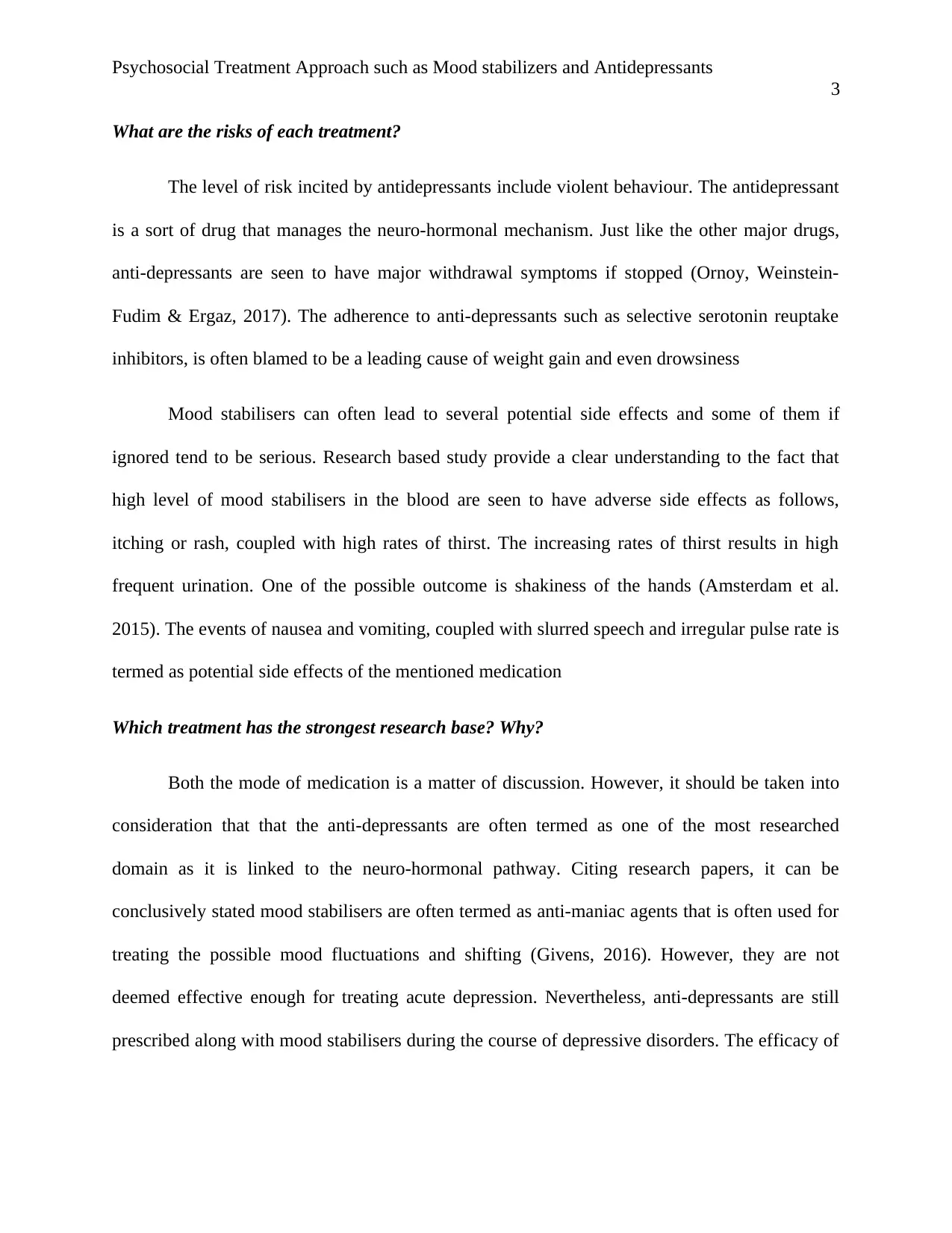
Psychosocial Treatment Approach such as Mood stabilizers and Antidepressants
3
What are the risks of each treatment?
The level of risk incited by antidepressants include violent behaviour. The antidepressant
is a sort of drug that manages the neuro-hormonal mechanism. Just like the other major drugs,
anti-depressants are seen to have major withdrawal symptoms if stopped (Ornoy, Weinstein‐
Fudim & Ergaz, 2017). The adherence to anti-depressants such as selective serotonin reuptake
inhibitors, is often blamed to be a leading cause of weight gain and even drowsiness
Mood stabilisers can often lead to several potential side effects and some of them if
ignored tend to be serious. Research based study provide a clear understanding to the fact that
high level of mood stabilisers in the blood are seen to have adverse side effects as follows,
itching or rash, coupled with high rates of thirst. The increasing rates of thirst results in high
frequent urination. One of the possible outcome is shakiness of the hands (Amsterdam et al.
2015). The events of nausea and vomiting, coupled with slurred speech and irregular pulse rate is
termed as potential side effects of the mentioned medication
Which treatment has the strongest research base? Why?
Both the mode of medication is a matter of discussion. However, it should be taken into
consideration that that the anti-depressants are often termed as one of the most researched
domain as it is linked to the neuro-hormonal pathway. Citing research papers, it can be
conclusively stated mood stabilisers are often termed as anti-maniac agents that is often used for
treating the possible mood fluctuations and shifting (Givens, 2016). However, they are not
deemed effective enough for treating acute depression. Nevertheless, anti-depressants are still
prescribed along with mood stabilisers during the course of depressive disorders. The efficacy of
3
What are the risks of each treatment?
The level of risk incited by antidepressants include violent behaviour. The antidepressant
is a sort of drug that manages the neuro-hormonal mechanism. Just like the other major drugs,
anti-depressants are seen to have major withdrawal symptoms if stopped (Ornoy, Weinstein‐
Fudim & Ergaz, 2017). The adherence to anti-depressants such as selective serotonin reuptake
inhibitors, is often blamed to be a leading cause of weight gain and even drowsiness
Mood stabilisers can often lead to several potential side effects and some of them if
ignored tend to be serious. Research based study provide a clear understanding to the fact that
high level of mood stabilisers in the blood are seen to have adverse side effects as follows,
itching or rash, coupled with high rates of thirst. The increasing rates of thirst results in high
frequent urination. One of the possible outcome is shakiness of the hands (Amsterdam et al.
2015). The events of nausea and vomiting, coupled with slurred speech and irregular pulse rate is
termed as potential side effects of the mentioned medication
Which treatment has the strongest research base? Why?
Both the mode of medication is a matter of discussion. However, it should be taken into
consideration that that the anti-depressants are often termed as one of the most researched
domain as it is linked to the neuro-hormonal pathway. Citing research papers, it can be
conclusively stated mood stabilisers are often termed as anti-maniac agents that is often used for
treating the possible mood fluctuations and shifting (Givens, 2016). However, they are not
deemed effective enough for treating acute depression. Nevertheless, anti-depressants are still
prescribed along with mood stabilisers during the course of depressive disorders. The efficacy of
⊘ This is a preview!⊘
Do you want full access?
Subscribe today to unlock all pages.

Trusted by 1+ million students worldwide
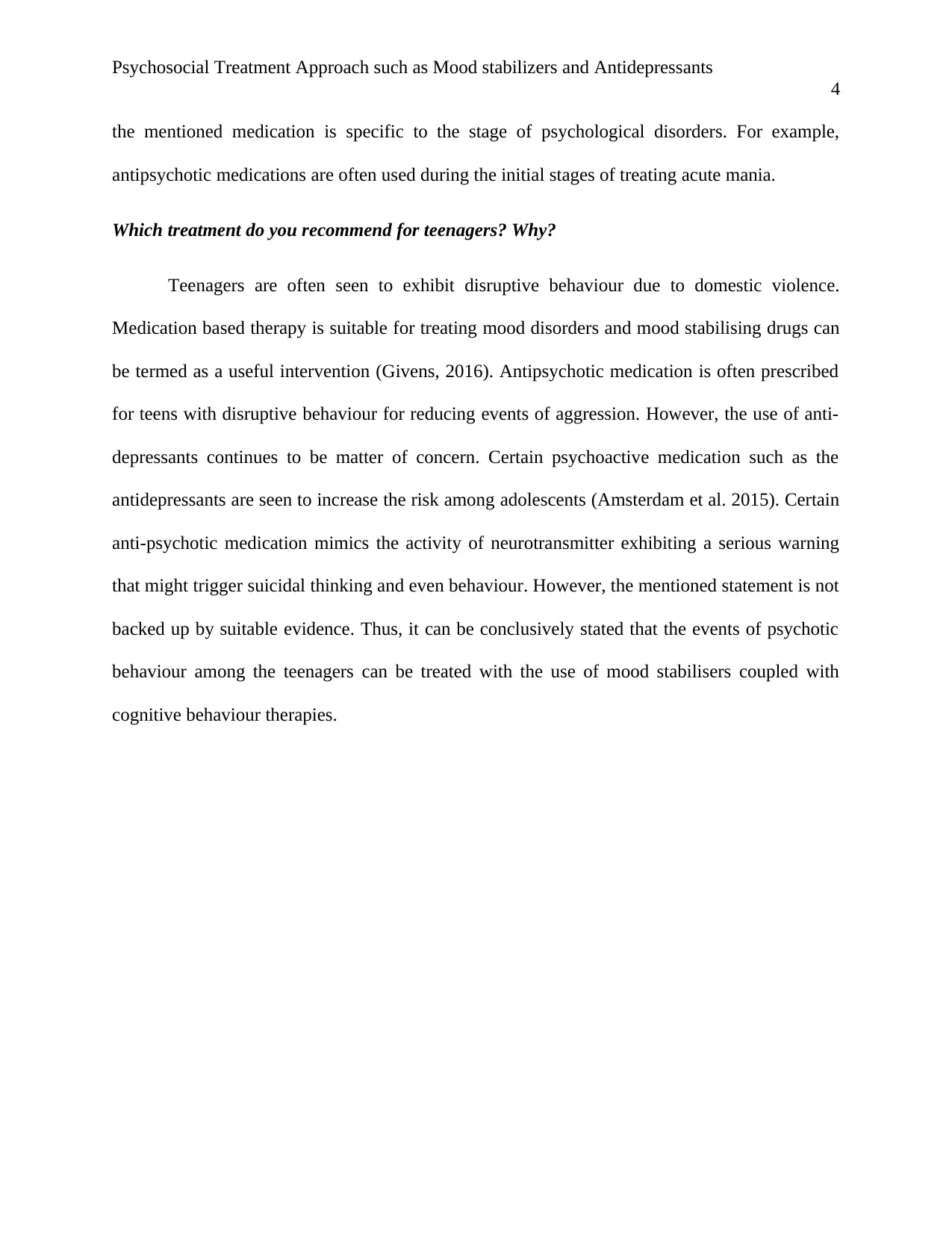
Psychosocial Treatment Approach such as Mood stabilizers and Antidepressants
4
the mentioned medication is specific to the stage of psychological disorders. For example,
antipsychotic medications are often used during the initial stages of treating acute mania.
Which treatment do you recommend for teenagers? Why?
Teenagers are often seen to exhibit disruptive behaviour due to domestic violence.
Medication based therapy is suitable for treating mood disorders and mood stabilising drugs can
be termed as a useful intervention (Givens, 2016). Antipsychotic medication is often prescribed
for teens with disruptive behaviour for reducing events of aggression. However, the use of anti-
depressants continues to be matter of concern. Certain psychoactive medication such as the
antidepressants are seen to increase the risk among adolescents (Amsterdam et al. 2015). Certain
anti-psychotic medication mimics the activity of neurotransmitter exhibiting a serious warning
that might trigger suicidal thinking and even behaviour. However, the mentioned statement is not
backed up by suitable evidence. Thus, it can be conclusively stated that the events of psychotic
behaviour among the teenagers can be treated with the use of mood stabilisers coupled with
cognitive behaviour therapies.
4
the mentioned medication is specific to the stage of psychological disorders. For example,
antipsychotic medications are often used during the initial stages of treating acute mania.
Which treatment do you recommend for teenagers? Why?
Teenagers are often seen to exhibit disruptive behaviour due to domestic violence.
Medication based therapy is suitable for treating mood disorders and mood stabilising drugs can
be termed as a useful intervention (Givens, 2016). Antipsychotic medication is often prescribed
for teens with disruptive behaviour for reducing events of aggression. However, the use of anti-
depressants continues to be matter of concern. Certain psychoactive medication such as the
antidepressants are seen to increase the risk among adolescents (Amsterdam et al. 2015). Certain
anti-psychotic medication mimics the activity of neurotransmitter exhibiting a serious warning
that might trigger suicidal thinking and even behaviour. However, the mentioned statement is not
backed up by suitable evidence. Thus, it can be conclusively stated that the events of psychotic
behaviour among the teenagers can be treated with the use of mood stabilisers coupled with
cognitive behaviour therapies.
Paraphrase This Document
Need a fresh take? Get an instant paraphrase of this document with our AI Paraphraser
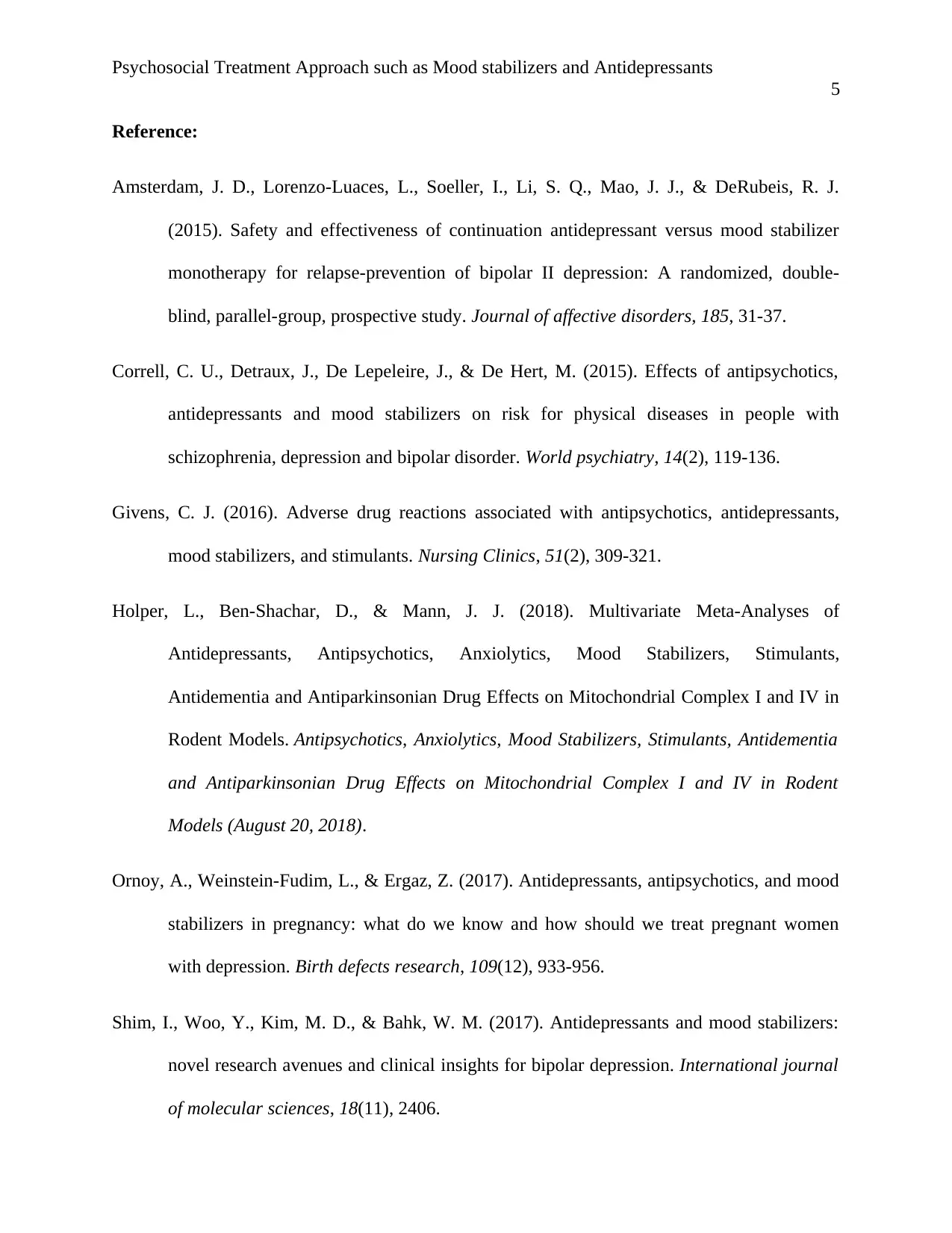
Psychosocial Treatment Approach such as Mood stabilizers and Antidepressants
5
Reference:
Amsterdam, J. D., Lorenzo-Luaces, L., Soeller, I., Li, S. Q., Mao, J. J., & DeRubeis, R. J.
(2015). Safety and effectiveness of continuation antidepressant versus mood stabilizer
monotherapy for relapse-prevention of bipolar II depression: A randomized, double-
blind, parallel-group, prospective study. Journal of affective disorders, 185, 31-37.
Correll, C. U., Detraux, J., De Lepeleire, J., & De Hert, M. (2015). Effects of antipsychotics,
antidepressants and mood stabilizers on risk for physical diseases in people with
schizophrenia, depression and bipolar disorder. World psychiatry, 14(2), 119-136.
Givens, C. J. (2016). Adverse drug reactions associated with antipsychotics, antidepressants,
mood stabilizers, and stimulants. Nursing Clinics, 51(2), 309-321.
Holper, L., Ben-Shachar, D., & Mann, J. J. (2018). Multivariate Meta-Analyses of
Antidepressants, Antipsychotics, Anxiolytics, Mood Stabilizers, Stimulants,
Antidementia and Antiparkinsonian Drug Effects on Mitochondrial Complex I and IV in
Rodent Models. Antipsychotics, Anxiolytics, Mood Stabilizers, Stimulants, Antidementia
and Antiparkinsonian Drug Effects on Mitochondrial Complex I and IV in Rodent
Models (August 20, 2018).
Ornoy, A., Weinstein‐Fudim, L., & Ergaz, Z. (2017). Antidepressants, antipsychotics, and mood
stabilizers in pregnancy: what do we know and how should we treat pregnant women
with depression. Birth defects research, 109(12), 933-956.
Shim, I., Woo, Y., Kim, M. D., & Bahk, W. M. (2017). Antidepressants and mood stabilizers:
novel research avenues and clinical insights for bipolar depression. International journal
of molecular sciences, 18(11), 2406.
5
Reference:
Amsterdam, J. D., Lorenzo-Luaces, L., Soeller, I., Li, S. Q., Mao, J. J., & DeRubeis, R. J.
(2015). Safety and effectiveness of continuation antidepressant versus mood stabilizer
monotherapy for relapse-prevention of bipolar II depression: A randomized, double-
blind, parallel-group, prospective study. Journal of affective disorders, 185, 31-37.
Correll, C. U., Detraux, J., De Lepeleire, J., & De Hert, M. (2015). Effects of antipsychotics,
antidepressants and mood stabilizers on risk for physical diseases in people with
schizophrenia, depression and bipolar disorder. World psychiatry, 14(2), 119-136.
Givens, C. J. (2016). Adverse drug reactions associated with antipsychotics, antidepressants,
mood stabilizers, and stimulants. Nursing Clinics, 51(2), 309-321.
Holper, L., Ben-Shachar, D., & Mann, J. J. (2018). Multivariate Meta-Analyses of
Antidepressants, Antipsychotics, Anxiolytics, Mood Stabilizers, Stimulants,
Antidementia and Antiparkinsonian Drug Effects on Mitochondrial Complex I and IV in
Rodent Models. Antipsychotics, Anxiolytics, Mood Stabilizers, Stimulants, Antidementia
and Antiparkinsonian Drug Effects on Mitochondrial Complex I and IV in Rodent
Models (August 20, 2018).
Ornoy, A., Weinstein‐Fudim, L., & Ergaz, Z. (2017). Antidepressants, antipsychotics, and mood
stabilizers in pregnancy: what do we know and how should we treat pregnant women
with depression. Birth defects research, 109(12), 933-956.
Shim, I., Woo, Y., Kim, M. D., & Bahk, W. M. (2017). Antidepressants and mood stabilizers:
novel research avenues and clinical insights for bipolar depression. International journal
of molecular sciences, 18(11), 2406.
1 out of 5
Related Documents
Your All-in-One AI-Powered Toolkit for Academic Success.
+13062052269
info@desklib.com
Available 24*7 on WhatsApp / Email
![[object Object]](/_next/static/media/star-bottom.7253800d.svg)
Unlock your academic potential
Copyright © 2020–2025 A2Z Services. All Rights Reserved. Developed and managed by ZUCOL.




